- Home
- Learn Japanese Language FAQ
- What are sokuon and long vowels?
What are sokuon and long vowels?
by Briam
(Virginia)

促音 (sokuon) and 長音 (chouon)
Can you explain sokuon and long vowels (chouon) in a kind of different way? They confused me and I don't know what they mean.
Reply:
Hi Briam,
促音 (sokuon)
促音 (sokuon) is the 小さい"つ" (chisaii "tsu") or small "tsu" that you can find in many Japanese words. It is used to mark a germinate consonant, which is formed by doubling the following consonant. It is about half the size of the original "tsu".
If you find the above explanation too confusing, it just means that when there is a sokuon between two hiragana, you have to pause slightly between them when pronouncing it. The best way to understand this is to listen to some examples.
Click on the play button of each of the following audio examples and listen carefully. You will understand the difference between a word with sokuon and without sukuon. Pay attention to the audios with sokuon and learn how to pause in between the two hiragana.
過去 (かこ - kako): past
括弧 (かっこ - kakko): parenthesis
歌 (うた - uta): song
売った (うった - utta): sold
How to key in sokuon in you PC or smartphone?
You can type out sokuon by keying in an additional same letter that follows the small "つ".
For example, if you key in "uta" you will get "うた". To enter sokuon in between the two hiragana, key in "utta" (an additional letter "t") and you will get "うった".
--- uta (うた) → utta (うった)
If you key in "kako" you will get "かこ". To enter sokuon in between the two hiragana, key in "kakko" (an additional letter "k") and you will get "かっこ".
--- kako (かこ) → kakko (かっこ)
Long Vowels or 長音 (chouon)
Long vowels or 長音 (chouon), as its name implies (longer sound), is the extension of length (usually double the length) of pronunciation of the vowel in a word.
How Long Vowels are represented?
There are rules that govern how the long vowels are represented:
1. For long vowel ended with "あ (a)" sound, add an extra "あ"
Example: おばさん (obasan) → おばあさん (obaasan - お婆さん)
2. For long vowel ended with "い (i)" sound, add an extra "い" after it.
Example: おじさん (ojisan) → おじいさん (ojiisan - お爺さん)
3. For long vowel ended with "う (u)" sound, add an extra "う" after it.
Example: くき (kuki) → くうき (kuuki - 空気)
4. For long vowel ended with "え (e)" sound, add an extra "え" after it.
Example: おねさん (onesan) → おねえさん (oneesan - お姉さん)
However, there are situations where long vowel ended with "え (e)" sound is added with an extra "い" after it.
Example: えが (ega) → えいが (eiga - 映画)
5. For long vowel ended with "お (o)" sound, add an extra "う" after it.
Example: ここ (koko) → こうこう (koukou - 高校)
However, there are situations where long vowel ended with "お (o)" sound is added with an extra "お" after it.
Example: おきい (okii) → おおきい (ookii - 大きい)
Click on the play button of each of the following audio examples and listen carefully. You will understand the difference between a word with chouon and without chouon. Pay attention to the audios with chouon and learn how the extension of the sound like.
叔母さん (おばさん - obasan): aunt
お婆さん (おばあさん - obaasan): grandmother
叔父さん (おじさん - ojisan): uncle
お爺さん (おじいさん - ojiisan): grandfather
ここ (koko): here
高校 (こうこう koukou): high school
Long Vowels of Katakana
Rather than adding a second vowel as in hiragana, katakana uses a short dash "ー" to represent the extension. Therefore it's much simpler for long vowels in katakana because you don't need to remember which additional vowel to add for the extension.
Click on the play button of each of the following audio examples to listen to the chouon of katakana.
セーター (se-ta-): sweater
タクシー (takushi-): taxi
Related Pages
Basic hiragana chart.
Basic katakana chart.
How to pronounce hiragana characters?
How to pronounce katakana characters?
Hope this helps,
Kia Leng








